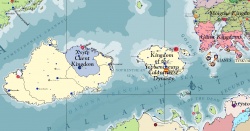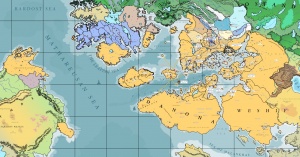Yophenthean Empire
The Yophenthean Empire comprises the period of Yophenthean rule beginning in the fourth century when Erechórebese military might expanded beyond the island. The Arathracian monarchy had firmly united all the Goldenling and Dramute tribes of Erechóreb in the third century and created the military and theocratic foundation for continued growth of the royal domains of the children of Arathrax. The fourth century is regarded by historians as the beginning of the empire as the Arathracian monarchy actively pursued its god-given mandate to bring all the world under the dominion of Arathrax and began the subjection and indoctrination of other peoples. The long duration and imperial extent of the Yophentheans ensured that their culture and religion would become a permanent element of the Pallathantic Region.
History
The Yophenthean Empire expanded with seemingly unstoppable momentum from the third to the seventh century. Thereafter until the early 800's, expansion reduced as the Yophenthean rulers concentrated their efforts on maintaining the vast dominion of their forebears in the face of ever-increasing assaults from nomadic sky tribes in the east and restless tribes elsewhere.
Calántuvese Yophenthea
395 to 476

The Calántuvese Dynasty, 396 AI to 476 AI, arose after the mythical rule of the Sons of Aireánnau. The roles of the original king were divided into military and hieratic roles, setting the precedent for a dual monarchy in the centuries ahead. The Calántuvil Family, descended from Saint Erigándor, assumed the mantle of the military and political king. The descendant of Erithráigean officiated as the high priest and spiritual patriarch of the Yophenthean Tribe and high priest of all the sun priests of the Arathracian religion throughout the little empire.
Early Yophenthean Empire
479 to 533 The Early Yophenthean Empire was a period of great territorial expansion, concluding with the conquest of the Midretassene Empire.
High Yophenthean Empire
The High Yophenthean Empire from the middle of the sixth century to the middle of the ninth century marks the greatest extent of the Yophenthean Empire and is generally considered the pinnacle of its cultural achievements. During this nearly three century period, the functions of priest-king and monarch Yophenthea were held in a single office. The legate patron governed in behalf of the priest-king. Engineering and artistic achievements included the Samagolean Wall, most of which was built in this period, and the grandiose architectural temples of Arathrax that spread throughout the empire. Modern Arathracian writers often point to this time as the very best of the Yophentheans' accomplishments.
Decline of the Yophenthean Empire
The decline of the empire is generally noted over nearly the last century and half up to the Fall of Yophénthë in 986. During this period, the imperial capital was sacked three times with the final sack constituting what historians have traditionally seen as the Fall of the Yophenthean Empire.
Late Yophenthean Empire
840 to 986 AI
Yophenthean Successor States
Although not considered part of the empire properly, the Yophenthean Successor States were the direct heirs to the Yophenthean Empire. Arathraciot families became regional powers, ruling many archdioceses of the empire as local kings. They successor states frequently cooperated with each other, but were internally wracked with conflicts and struggles for control of their kingdoms. The ongoing migration of Sky Tribes from greater Thrace and their settlement in the lands of the former empire continued to disrupt and undermine these regional Arathracian kingdoms.
Rulership of the Yophenthean Empire
The constitution of the monarchy underwent several transformations through its history.
Asdarography and Demography
The Yophenthean Empire is largest of all human empires which history can vet. "It is not possible to study the Empire of the Yophentheans without long reflection on its superlative magnitude." Only the mythical empires of the titans and the gods were greater. At its greatest extent around 800 AI, the empire covered some or all of five continents and all the isles of the Pallathantic Sea under its rule. The Yophenthean Empire governed all of Danona, all of Pytharnia, the lands that are now Amerzcelindo, all of the lands that now comprise the Aurician Empire, all of Shelekhumbia and the western half of Weshif, including Shagrela'al, and the lands of southern Barathorn that now comprise Glaye. The Yophentheans called any land outside of their rule as the "Dawning Lands" and its intended use was chiefly for Thrace.
Languages
The official language of the Yophentheans was their own tongue, Classical Yophenthean, and they spread this tongue throughout their empire through conquest, religion, and theocratic bureaucracy. Colonization also brought the language greater permanency in the lands where Yophentheans emigrated and settled. However, the Yophentheans only insisted upon their language for the higher observances of their religion and official government business. Languages, including Classical Ithatian, Midretassene, and Khahonri were permitted and in many cases studied by Yophenthean governors to better inform their administration. The Midretassene Language continued as medium of culture and literacy in Corundian peninsula.
During the time of the Yophenthean Successor States, Classical Yophenthean continued to be spoken throughout the former provinces of the empire. In some places, the imperial language persisted and changed into a vulgar version particular to the region. In other places, the native language re-affirmed itself with a rich borrowing of Yophenthean words. Modern languages derived from Classical Yophenthean include Asbardian, Ambrinquan, Corundian, Glaikish, and Erechórebese.
Arathracian Religion
Classical Arathracianism
Classical Arathracianism was based on legends, rituals, oral accounts, the Sixteen Tablets of Arathrax, and family traditions. It was not intended as a religion for the common people and was not promulgated among the masses of the empire until the Edict of Culfarran. Artistic relics of the Arathracian Cult and temple practices teach us much about the classical version of the religion.[1]
Democratization of Arathracianism
Edict of Culfarran
The Edict of Culfarran, issued in 867, opened up the Rites of Arathrax to all citizens of the empire.
Theocracy and Military
Early Hierarchy
Early Arathracian Yophenthean Society was very hierarchical and this pattern remained dominant with changes through the empire. The ruling classes were descended from the union of Aireánnau Mother of the Folk and the god Arathrax. The priest-king or córonde sat at the top of the kingdom. The royal family was next, consisting of members who could trace their lineage to Arathrax and Aireánnau through Erithraigean. Next were the senators who were descended from the oldest sons of the remaining seven of the Eight Sons of Aireánnau. The Knights were the offspring of the younger sons of the seven. Royals and Knights were all considered priests by virtue of their descent and there was no separate priestly class. The córonde was the king and high priest. The Goldenlings of Erechóreb and the Dramutes, now somewhat mixed in lineage, constituted the new commoners. The pre-Arathracian aristocrats of the goldenlings filled the ranks of the officers of the military. The remaining goldenlings filled in the ranks of the enlisted. The heirs of the Dramutes continued to figure highly in commerce and engineering.
As the empire expanded and subjected other princes into its state cult, their peoples became subjects of the Arathracian Monarchy. Of these, the warriors were united to the Yophenthean military apparatus. Giants of the three isles, merfolk, Dragon Knights, and more were impressed into the service of Erechóreb's expanding dominion.
Society
Economy
Skycraft Resources
During the late Yophenthean Empire, the skyfaring tribes of the Jaggudorns and of Barathorn increasingly demanded resources for the construction of skycraft. Resources native to the Jaggudorns were growing scarce. Additionally, the fleeglesilk produced by the Merfolk and the Tritons was superior for the construction of skysails. As all the sites of the production of fleeglesilk lay within the bounds of the Yophenthean Empire, the empire effectively controlled the prices of this resource prized by the restless barbarians on its mountainous frontier. The skyfaring tribes of the Jaggudorns considered the empire hostile to them economically and culturally. As the relationship between the Yophentheans and the Jaggudorner Sky tribes deteriorated, religious ideology came to the forefront of the conflict.
Architecture and Engineering
Arathracian Dome
The great, sprawling dome of the Arathracian Temple is the most well-known shape of Yophenthean Architecture and was employed in Temples and Basilicas. The first use of the dome on a large scale was in the late sixth century (ca 570) in Yophénthë for the great high and holy Temple of Arathrax the Progenitor.
Samagolean Wall
A series of immense defensive fortifications built between ca. 680 to 920 (about 240 years), built on the far eastern boundary of the Yophenthean Empire, reaching from the southwest Ambracian Jaggudorns across Asdauria and past the Adamantine Mountains to the edge of the Sea of a Thousand Curses. Yophentheans used forced and auxiliary labor of uhlaks and giants to construct the great walls and forts. These constructions served to hold off migrating tribes of the steppes, including free uhlaks, trolls, giants, and humans. These fortifications today serve as a tangible reminder of the immense reach and power of the Yophenthean Empire.
The Arts
Literacy and Education
Literature
Legacy
Notes
Sources
 Primary Sources
Primary Sources
- Against Zebdomanius, ca 870
- Book of the Wars of Arathrax, survives only in excerpts and quotes
- Braffgrum Ancuvetácodh, Heliotheological Museum of Amyrn, fifth century
- Bryndidine Gloss, 8th century
- Commandments of Arathrax, third to sixth centuries
- Funerary and Civil Monuments of the Arathracians, Honcha dhal Cumdha, 2376, Asdbardian, Catalogues major stone relics and funerary monuments of the Yophenthean Rulers of Asbardy
- Law of the Sixteen Golden Tablets, fifth century
- Sons of Erithraigean, Taspha dalc Pholmagailna, Year, 419, history of Arathracian rulers in the fourth century
- War of the Allies, Erreach dalc Smiahairna, 572, Classical Yophenthean, War between Erechóreb and eastern Pallathantic, culminating in the Battle of Siul, 513
- Woes of Yophenthea, late tenth century
 Secondary Sources
Secondary Sources
- Brief History of the Knights Templar of Arathrax, 2703, Aigueadal dhailg Bardinda Threvandusil
- Concerning Warfare Among the Pytharnians, Shibziadáin ishbiz Bakhuilub, 1011
- Early Arathracian Priest-Kings, Caspain dhal Daghoidhe Thiga dhaila Ithraig, 2468, Asbardian, History of First Rulers of Yophenthea, beginning with Erithraigean
- History of Erechóreb, A, 2028
- Holy City of Arathrax, 1073
- Institutes of Ancient Yophenthean Law
- Journal of Arathracian Studies
- Legends of the Erismadhalian Swords, Iguleach Galbry dhailg Duadhna, 1613
- Magnificent Ruination of Old Yophénthë, 2513
- Pre-Aireannavian Cremations of Tireathiain, Thimul dhailg Erifirve, 2737
- Regionary Catalogue of Yophénthë, 2617, multiple authors
- Zulmanichite Cult of the Late Yophenthean Empire, 2594
See Also
- Aftermath of the Fall of the Yophenthean Empire
- Fall of the Yophenthean Empire
- Goldenling Tribes of Erechóreb
- List of the Rulers of the Golden Empire of Pytharnia
- List of Yophenthean Rulers of Erechóreb
- Portal:Yophenthean Empire
- Third Sack of Yophénthë
- Yophénthë
- Yophenthean Expansion of the Fourth through Sixth Centuries
- Yophenthean Kingship
- Yophenthean Law
- Yophenthean Military Organization
- Yophenthean Successor States
| This article is a stub. It requires further development by the creator. |
